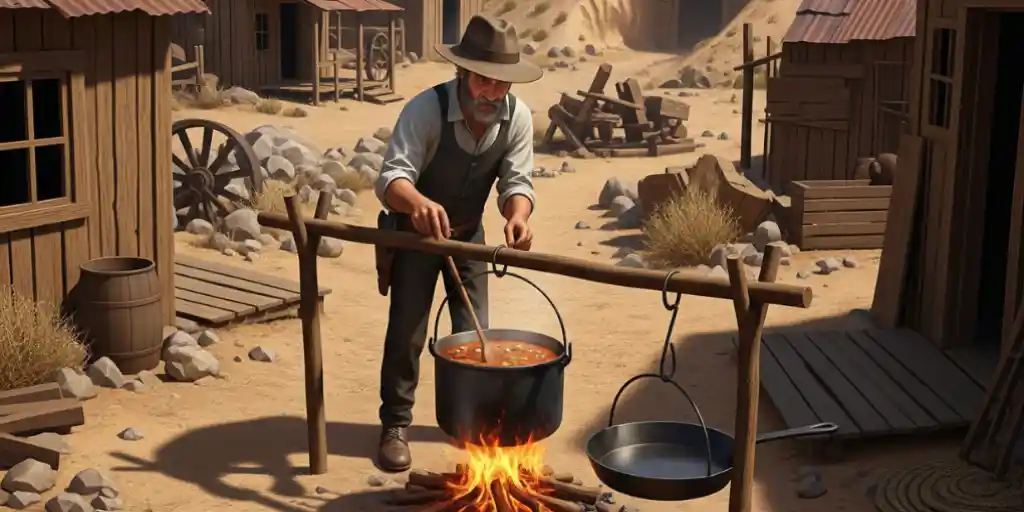In the windswept remains of desert mining towns, kitchens once ran on coal, cast iron, and survival. Long before electricity and supermarkets, miners and their families cooked hearty meals with what they had, in places where the nearest store was days away. Today, these ghost-town kitchens tell stories—not just of gold and silver, but of fire, grit, and flavor born in dust.
In this blog, we’ll explore how cooking worked in old desert mining towns, what tools and ingredients were used, and how you can recreate frontier meals with modern simplicity. From sourdough starters to cast-iron cooking, it's a taste of history with a smoky edge.
🔍 What Was Cooking Like in Mining Settlements?
Life was harsh—and cooking reflected that:
-
No refrigeration or running water
-
Meals made over open fires, wood stoves, or coals
-
Ingredients hauled in wagons or grown in small plots
-
Recipes focused on bulk, calories, and durability
But meals still brought warmth, connection, and occasional celebration.
💡 Why Cooking Was Central to Mining Life
Food in desert camps wasn’t just sustenance—it was survival, morale, and medicine:
-
Kept miners fueled during 10–14 hour shifts
-
Gatherings around meals kept spirits high
-
Herbal and spice blends often doubled as remedies
-
Baking bread or beans became a shared daily ritual
So yes—in towns built on gold, bread was the real treasure.
✈️ Typical Ingredients in Desert Mining Towns
| Staple | How It Was Stored | What It Was Used For |
| Flour & cornmeal | In barrels or cloth sacks | Bread, biscuits, tortillas |
| Salt pork & jerky | Cured or smoked | Stews, beans, or fried with eggs |
| Beans & dried legumes | Stored dry in bags | Daily protein source |
| Coffee & chicory | Tins or jars | Morning wake-up brew |
| Lard or tallow | Rendered & stored in crocks | Frying, baking, and pan-searing |
🛡️ Top Cooking Tricks from the Desert Frontier
Let’s explore the practical methods and culinary wisdom pioneers used to cook with limited resources and endless heat.
1. ✅ Bake Bread with a Dutch Oven and Coals
Why it matters: This was the mining town’s portable oven.
Desert Cooking Hack:
-
Place dough inside a Dutch oven with hot coals above and below.
-
Lid keeps in moisture and heat evenly.
-
Bonus: Bake biscuits, pies, and beans in same pot.
2. 🔥 Use Rocks and Ash as Heat Regulators
The trap: Direct fire can burn or overcook fragile ingredients.
Why it’s clever:
-
Hot rocks and ash were used as makeshift “ovens.”
Pioneer Trick:
-
Dig a small trench, line with hot rocks, cover food in foil or leaves, and bury for slow roast.
3. 🫘 Make Miner’s Beans the Night Before
Problem: Beans took hours to cook—but slow heat helped.
Why it worked:
-
Cooked overnight in embers or coals for flavor + convenience.
Old Camp Trick:
-
Soak beans in a pot, add salt pork, onions, and a splash of molasses.
-
Cover and nestle near the fire overnight—hot, ready by morning.
4. 🧄 Use Herbs and Wild Greens for Flavor
Why it matters: Flavor wasn’t a luxury—it was for health too.
Desert Cooking Hack:
-
Miners foraged wild sage, garlic, or mint for stews.
-
Dried spices were gold—cumin, chili, or coriander added depth.
5. 🍳 Master Cast Iron Cooking
Problem: Limited pots = multi-use tools.
Why it’s essential:
-
One skillet could bake, fry, sauté, or roast.
Survival Cooking Tip:
-
Season well with lard or oil.
-
Never wash with soap—just rinse and wipe.
💳 Best Ways to Experience Mining Town Cooking Today
| Experience/Tool | Purpose | Where to Find It |
| Dutch oven cookouts | Recreate old-style meals outdoors | Campgrounds, living history events |
| Ghost town food tours | Learn culinary history on site | Bodie (CA), Jerome (AZ), Ballarat (CA) |
| Cast iron cooking guides | Modern skills for old methods | Lodge or Cowboy Kent Rollins tutorials |
| Desert foraging walks | Learn wild herbs used in mining towns | Arizona, Nevada, Rajasthan villages |
| Mining museum exhibits | Explore kitchen tools & food displays | Elko Mining Museum, Tonopah, Jaisalmer |
🔍 Real User Example
“I visited an old silver camp in Rajasthan where they still bake millet flatbreads on hot stones. The flavor, the simplicity—it brought the desert to life in my mouth.” – Harish, Culinary Historian
🧠 Pro Tips to Remember
-
Use dry goods over perishables for desert trips
-
Practice cast iron cooking before your adventure
-
Always bring clean water for cooking—towns didn’t have plumbing
-
Don’t underestimate the power of fire, ash, and time
-
Cooking slow = eating well in the desert
💬 Final Thoughts: The Kitchen Was the Campfire
Cooking in desert mining towns wasn’t glamorous—it was gritty, smoky, and sacred. From biscuits on hot coals to beans slow-cooked in ash, meals were moments of hope in a harsh world.
✅ Don’t just eat—eat like a pioneer.
✅ Don’t just cook—cook with legacy.
✅ Don’t just visit ruins—taste the survival that built them.
The mines are empty—but the fire still burns.
📌 FAQs About Mining Town Cooking
Q1. Is it safe to cook like they did in old mining towns?
Yes—with care. Use clean fire, seasoned cast iron, and fresh water.
Q2. Can I find authentic recipes from that era?
Yes—many museums and cowboy cookbooks preserve them. Look for "pioneer cooking" guides.
Q3. What’s the most iconic mining town dish?
Beans with salt pork or cornbread, followed by skillet-fried potatoes.
Q4. Where can I try this food today?
Heritage parks, mining museums, or ghost town festivals often serve it live.
